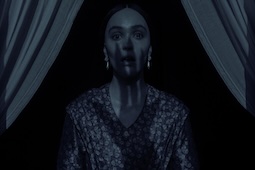
Our Danny Boyle season continues on May 21st with the bloodcurdling 28 Days Later. If you haven't experienced this pulse-pounding chiller on the big screen before, now's your chance for just £5 a ticket. The screening also coincides with the exciting news that 28 Years Later will hit our screens in 2025.
Here's why 28 Days Later remains a cult horror classic after all this time.
1. It revitalised the zombie movie for a new generation
Technically, the enemies in 28 Days Later aren't zombies, they're humans infected with the Rage virus, but one instinctively makes the association based on the sight of people behaving in an abnormal, terrifying manner.
George A. Romero popularised the notion of shuffling, shambling flesh-eating zombies in his groundbreaking classic Night of the Living Dead (1968). Fast-forward to 2002 and the typically inventive Boyle, working with screenwriter Alex Garland (more on whom below), virtually invented the notion of the fast 'zombie', further augmented by Anthony Dod Mantle's raw, freestyling camerawork that's often akin to a documentary.
Can you imagine anything more terrifying than a once-benign human now baying for your blood and capable of running at the speed of an Olympic athlete? It was a brilliantly simple conceit that changed the zombie movie overnight. Zack Snyder's Dawn of the Dead remake (2004) duly ran with the notion of fast zombies, as did most other crepuscular, flesh-eating chillers afterward. The likes of Spanish found-footage horror REC (2007) and the Brad Pitt epic World War Z (2013) all owe their genetic makeup to 28 Days Later.
2. It introduced Cillian Murphy to the world
Cillian Murphy is now cemented as the Oscar-winning star of Oppenheimer and it's hard to imagine a time when he was a relative unknown. He had acted in things prior to 28 Days Later but it was this film that put him on the map. Murphy plays the bewildered bike courier Jim who misses onset of the pandemic while in a coma in hospital. Upon waking up, he realises that the UK has gone to hell in a handcart, and he becomes our de-facto guide to this eerie apocalypse.
Murphy's striking blue eyes (with which Christopher Nolan became infatuated during the making of Batman Begins in 2005) and rangy frame are put to excellent use. Jim is no superhero possessing notable physical attributes, but a commonplace guy making the best of an extraordinary situation, which makes his final blast of savagery, retaliating against Colonel West (Christopher Eccleston) and his men, all the more impactful. It makes us realise that the divide between rationality and frenzied, animalistic chaos is the narrowest of margins.
It was 28 Days Later that put Murphy in Hollywood's sights, giving rise to his position as Christopher Nolan's muse. As well as Batman Begins and Oppenheimer, he's appeared in the director's films The Dark Knight (2008) and The Dark Knight Rises (2012), Inception (2010) and Dunkirk (2017).
3. It gave Naomie Harris a starring role
Like Cillian Murphy, Naomie Harris shot to A-list fame off the back of 28 Days Later. She plays Selina, the committed experienced survivor who thinks nothing of macheteing her fellow humans to death if they become infected. Her slow-burn relationship with Jim is convincingly sketched and Harris, like Murphy, is wholly convincing as a person who's had to adapt street smarts and primal savagery in the blink of an eye.
Following 28 Days Later, the versatile Harris has appeared as Eve Moneypenny in three Daniel Craig James Bond films, Skyfall (2012), Spectre (2015) and No Time To Die (2021). She also scored a critical success with her Oscar-nominated turn in Barry Jenkins' shattering Moonlight (2016).
4. It showcased a striking debut script from Alex Garland
Who can forget that classic opening sequence from 28 Days Later? It shows an isolated and vulnerable Jim wandering around the deserted streets of central London, a John Wyndham-esque sci-fi apocalypse for the new millennium. This was one of many striking ideas put forward by novelist-turned-screenwriter Alex Garland who, at the time of the film's release, was still riding high of the success of his 1996 novel The Beach (its subsequent film adaptation in 2000, directed by Danny Boyle and starring Leonardo DiCaprio, is best forgotten).
Garland has admitted that the film's memorable opening barely stretched to two paragraphs in the script and he's credited Boyle for spinning the sequence into a superb piece of cinematic art. Nevertheless, Garland's script helped cement him as a modern sci-fi master, a writer who utilises fantastical conceits to interrogate human weakness to frequently unsettling effect.
Boyle and Garland would later collaborate on 28 Weeks Later and Sunshine, both released in 2007. Garland's success with his directorial debut Ex-Machina (2015), a contemporary examination of humanity lurking within artificial intelligence, owes itself to 28 Days Later, as does his later work on the Jeff Vandermeer adaptation Annihilation (2018) and this year's brutal photojournalist allegory Civil War.
5. It cemented John Murphy's soundtrack as an instant earworm
John Murphy's slow-burn slice of electronica 'In the House in a Heartbeat' is now synonymous with escalating tension and terror, and it came from 28 Days Later. It only appears at the end of the film during Jim's feral rampage on Colonel West's men, but it has been adopted as the signature theme of the wider 28 Days franchise. (One hopes it will appear in 28 Years Later.)
Murphy's layering of brutal distortion, combined with his instinctive flair for a memorable rhythmic hook, perfectly encapsulates the world of the film: things may be quiet on the surface, but things will inevitably boil over to explosive effect. It was Murphy's first collaboration with Danny Boyle and gave rise to future partnerships including Sunshine (2007), which unleashed the equally addictive, soaring Adagio in D-Minor upon the world.
Click the link below to book your tickets for 28 Days Later. It screens on May 21st as part of our Danny Boyle season.










.jpg)


.jpg)
.png)






